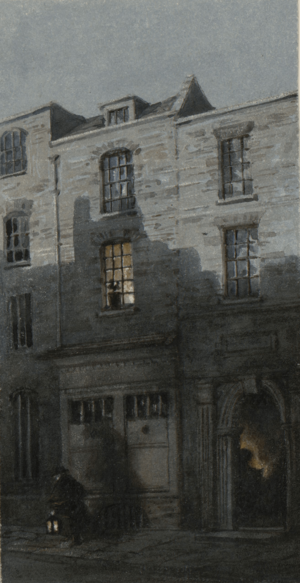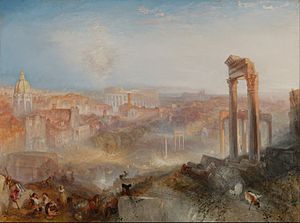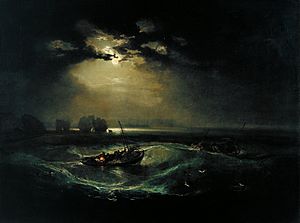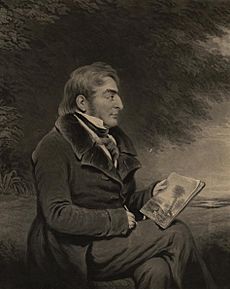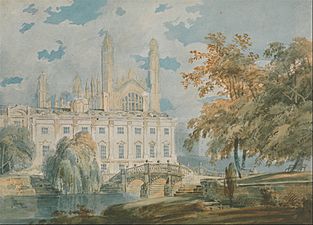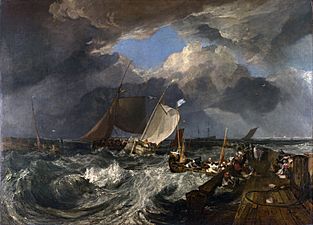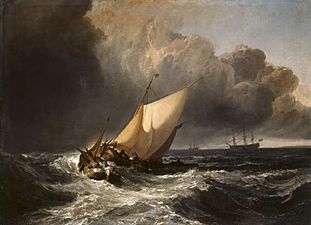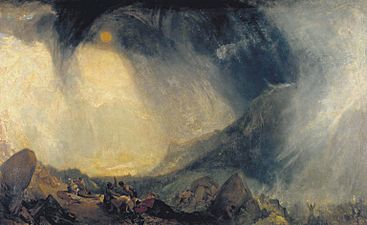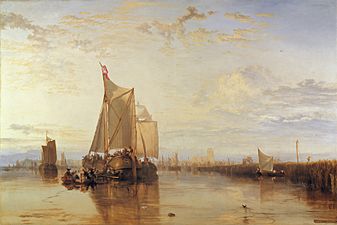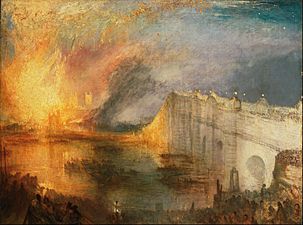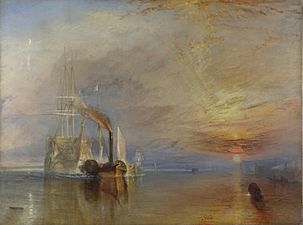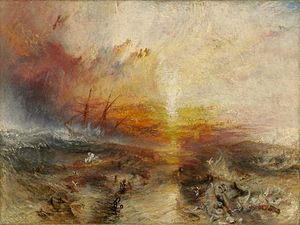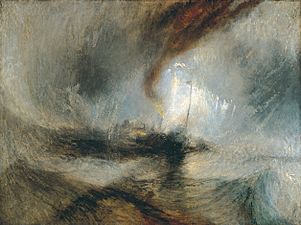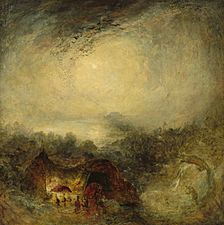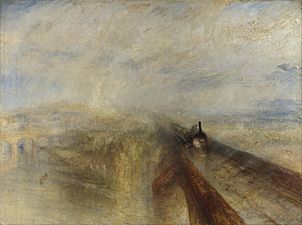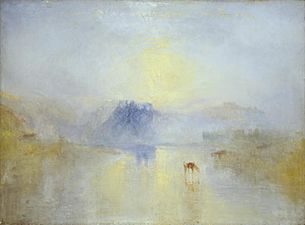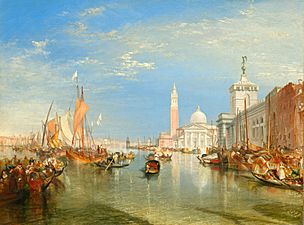J. M. W. Turner facts for kids
Quick facts for kids
J. M. W. Turner
|
|
|---|---|
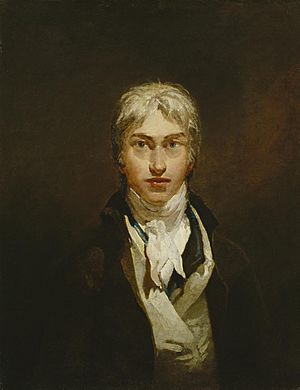
Self-Portrait, oil on canvas, c. 1799
|
|
| Born |
Joseph Mallord William Turner
23 April 1775 London, England
|
| Died | 19 December 1851 (aged 76) Chelsea, London, England
|
| Resting place | St Paul's Cathedral |
| Education | Royal Academy of Arts |
| Known for | Paintings |
|
Notable work
|
|
| Movement | Romanticism |
Joseph Mallord William Turner (born April 23, 1775 – died December 19, 1851) was a famous English painter. He was also a printmaker and watercolour artist. People often called him William Turner during his lifetime.
Turner is well-known for his amazing use of color and his imaginative landscape paintings. He also painted powerful and often stormy scenes of the sea. He created a huge number of artworks: over 550 oil paintings, 2,000 watercolours, and 30,000 drawings. A leading art critic, John Ruskin, praised his work. Today, Turner is seen as an artist who made landscape painting as important as history painting.
Contents
Biography
Early Life and Family
Joseph Mallord William Turner was born in London, England, on April 23, 1775. His father, William Turner, was a barber and wig maker. His mother, Mary Marshall, came from a family of butchers.
Turner had a younger sister, Mary Ann, who was born in 1778 but sadly died in 1783. His mother began to show signs of mental illness around 1785. She was admitted to a hospital in 1799 and later to a mental asylum, where she passed away in 1804.
Because of his mother's illness, Turner was sent to live with his uncle, Joseph Mallord William Marshall. His uncle was a butcher in Brentford, a small town near the River Thames. While there, Turner went to school. His earliest known artworks are simple colorings of pictures from a book about old English buildings.
Around 1786, Turner went to Margate on the coast of Kent. He drew many pictures of the town and its surroundings. These drawings hinted at the amazing art he would create later. By this time, his father was already showing and selling Turner's drawings in his shop. His father proudly told another artist, "My son, sir, is going to be a painter."
In 1789, Turner stayed with his uncle again, who had moved to Sunningwell. A whole book of his drawings from this time still exists, along with a watercolour of Oxford. Turner often made pencil sketches outdoors. He then used these sketches to create his finished paintings. This became his main way of working throughout his career.
Many of Turner's early sketches were of buildings or focused on perspective. When he was young, he worked for several architects. By the end of 1789, he also began to study with Thomas Malton. Malton was a draughtsman who specialized in drawing landscapes and buildings. Turner learned important skills from him, like copying and coloring pictures of British castles and abbeys. Turner later called Malton "My real master." Drawing landscapes was a good way for young artists to earn money for their studies.
Becoming an Artist
Turner joined the Royal Academy of Arts in 1789 when he was 14. He was accepted into the academy a year later by Sir Joshua Reynolds. Turner was first interested in architecture, but his teacher advised him to focus on painting.
His first watercolour, A View of the Archbishop's Palace, Lambeth, was shown at the Royal Academy exhibition in 1790. Turner was only 15 years old. As a student, Turner learned to draw from plaster models of ancient sculptures. He attended classes at the academy over a hundred times between 1790 and 1793. In 1792, he began to draw the human body in life classes.
Turner showed watercolours every year at the academy. In the winter, he painted, and in the summer, he traveled widely across Britain. He especially visited Wales, where he made many sketches. These sketches helped him create his studies and watercolours, often focusing on buildings. In 1793, he showed a watercolour called The Rising Squall – Hot Wells from St Vincent's Rock Bristol, which is now lost. This painting showed his early skill in capturing weather effects. A writer named Peter Cunningham later said this painting was "a noble attempt at lifting landscape art out of the tame insipidities." It showed Turner's mastery of effects for the first time.
In 1796, Turner showed Fishermen at Sea, his first oil painting at the academy. It was a night scene of boats in danger near the Needles off the Isle of Wight. This painting was praised by critics and helped establish Turner's reputation as a painter of both oil and sea scenes.
Turner traveled a lot in Europe. He visited France and Switzerland in 1802 and studied in the Louvre in Paris that same year. He also made many trips to Venice.
An important supporter of his work was Walter Ramsden Fawkes of Farnley Hall in Yorkshire. Fawkes became a close friend of Turner. Turner first visited Otley in 1797 when he was 22. He was hired to paint watercolours of the area. He loved Otley so much that he returned there throughout his career. It is believed that the stormy background of his painting Hannibal Crossing The Alps was inspired by a storm he saw over the Chevin while staying at Farnley Hall.
Turner was also a frequent guest of George O'Brien Wyndham, 3rd Earl of Egremont, at Petworth House in West Sussex. He painted scenes from the house grounds and the Sussex countryside. Petworth House still displays many of his paintings.
Later Years
As Turner got older, he became more unusual in his habits. He had few close friends, except for his father. His father lived with him for 30 years and helped him in his studio. His father's death in 1829 deeply affected him, and after that, he often felt sad.
Turner never married. He passed away from cholera on December 19, 1851, at the home of Sophia Caroline Booth in Cheyne Walk in Chelsea. He is buried in St Paul's Cathedral, near the painter Sir Joshua Reynolds. His last words are said to have been "The Sun (or Son?) is God," but this might not be true.
Turner's friend, the architect Philip Hardwick, helped arrange his funeral. He wrote to Turner's friends, "I must inform you, we have lost him."
Art
Painting Style
Turner's artistic talent was recognized early in his life. He had enough money to try new things freely in his art. His later works are known for their bright colors and broad, hazy layers of paint. Some people called his later pictures "fantastic puzzles."
Turner was seen as a brilliant artist. The English art critic John Ruskin said he was the artist who could best "stirringly and truthfully measure the moods of Nature." However, some people didn't like his work. Sir George Beaumont, a fellow painter, called his paintings "blots."
Turner was inspired by shipwrecks, fires, and natural events like sunlight, storms, rain, and fog. He even saw the burning of Parliament in 1834 and drew many sketches of it. He was fascinated by the powerful force of the sea, which you can see in paintings like Dawn after the Wreck (1840) and The Slave Ship (1840).
Turner's major project in printmaking was the Liber Studiorum (Book of Studies). He worked on these seventy prints from 1806 to 1819. The Liber Studiorum showed his ideas for landscape art. It was based on Claude Lorrain's Liber Veritatis (Book of Truth). Claude had recorded his finished paintings, and copies of these drawings were very popular. Turner's prints were meant to be shared widely and divided landscapes into six types: Marine, Mountainous, Pastoral, Historical, Architectural, and Elevated or Epic Pastoral. Printmaking was a big part of his work. There's even a museum dedicated to his prints, the Turner Museum in Sarasota, Florida.
His early works, like Tintern Abbey (1795), followed the traditional style of English landscape painting. In Hannibal Crossing the Alps (1812), he already showed the destructive power of nature. Turner developed a unique painting style. He used watercolour techniques with oil paints, which made his art look light, flowing, and full of fleeting atmospheric effects.
In his later years, Turner used oil paints in a very thin, see-through way. He focused on showing pure light using shimmering colors. A great example of his mature style is Rain, Steam and Speed – The Great Western Railway, where the objects are almost hard to recognize. His intense colors and interest in changing light made his work very advanced for his time. It also influenced art in France. The Impressionists, especially Claude Monet, carefully studied his methods. Turner is also considered a pioneer of abstract painting.
In 1816, there was a lot of volcanic ash in the air from the eruption of Mount Tambora. This caused unusually beautiful sunsets, which inspired some of Turner's paintings.
John Ruskin said that an early supporter, Thomas Monro, greatly influenced Turner's style. Monro was a doctor and an art collector. Turner, along with other young artists, could copy works from famous landscape artists at Monro's house. This helped him improve his drawing skills. Monro's house also had watercolours by John Robert Cozens that showed amazing atmospheric effects. These paintings were a big discovery for the young Turner. They showed him that watercolours could convey feelings and moods, not just information.
Materials Used
Turner experimented with many different colors. He used pigments like carmine, even though he knew they wouldn't last long. He ignored advice from experts who told him to use more durable colors. Because of this, many of his colors have faded over time. Ruskin complained about how quickly his work decayed. Turner didn't seem to care about how his paintings would look in the future. He chose materials that looked good when they were freshly painted. By 1930, people were worried that both his oil and watercolour paintings were fading.
Gallery
-
Clare Hall and King's College Chapel, Cambridge, from the Banks of the River Cam, 1793, watercolour
-
Calais Pier, 1801, oil on canvas, National Gallery, London
-
Dutch Boats in a Gale, 1801, oil on canvas. For his painting Turner drew inspiration from the art of Willem van de Velde the Younger
-
Snow Storm: Hannibal and his Army Crossing the Alps, 1812, oil on canvas, Tate Britain
-
Dort or Dordrecht: The Dort packet-boat from Rotterdam becalmed, 1818, oil on canvas, Yale Center for British Art
-
The Burning of the Houses of Lords and Commons, 16 October 1834, oil on canvas, Cleveland Museum of Art
-
Valley of Aosta: Snowstorm, Avalanche and Thunderstorm, 1836–37, oil on canvas, Art Institute of Chicago
-
The Slave Ship, 1840, oil on canvas, Museum of Fine Arts, Boston
-
The Evening of the Deluge, c.1843, National Gallery of Art, Washington D.C.
-
Venice - The Dogana and San Giorgio Maggiore, c.1834, National Gallery of Art, Washington D.C.
Legacy
Turner left a large amount of money. He hoped it would be used to help artists who were struggling. He planned to build a special home for artists in Twickenham with a gallery for some of his paintings.
However, his will was challenged in court. In 1856, after a legal battle, some of his relatives received part of his money. Another part went to the Royal Academy of Arts, which sometimes gives out the Turner Medal to students.
Turner wanted his finished paintings to be given to the British nation. He intended for a special gallery to be built just for them. But this didn't happen because people couldn't agree on where to build it. Twenty-two years after his death, the British Parliament passed a law. This law allowed his paintings to be loaned to museums outside London. This started the process of spreading out his pictures, which Turner had wanted to keep together.
One of the biggest collectors of Turner's work was Henry Vaughan. When he died in 1899, he owned over a hundred of Turner's watercolours and drawings, plus many prints. His collection included almost every type of artwork on paper that Turner made. It showed the amazing variety and skill of Turner's work throughout his sixty-year career.
Vaughan gave most of his Turner collection to public galleries and museums in Britain and Ireland. He made a special rule: the watercolours should be shown to the public all at once, for free, and only in January. This showed he cared about protecting the art, which was unusual at the time.
In 1910, the main part of Turner's collection, including unfinished paintings and drawings, was moved to the Duveen Turner Wing at the National Gallery of British Art (now Tate Britain). In 1987, a new wing at the Tate, the Clore Gallery, was opened to house the Turner collection. However, some of his most important paintings are still in the National Gallery. This goes against Turner's wish that they be kept and shown together. More and more, his paintings are being loaned to other countries, ignoring his rule that they should stay permanently in his own gallery.
See also
 In Spanish: J. M. W. Turner para niños
In Spanish: J. M. W. Turner para niños
- List of paintings by J. M. W. Turner


